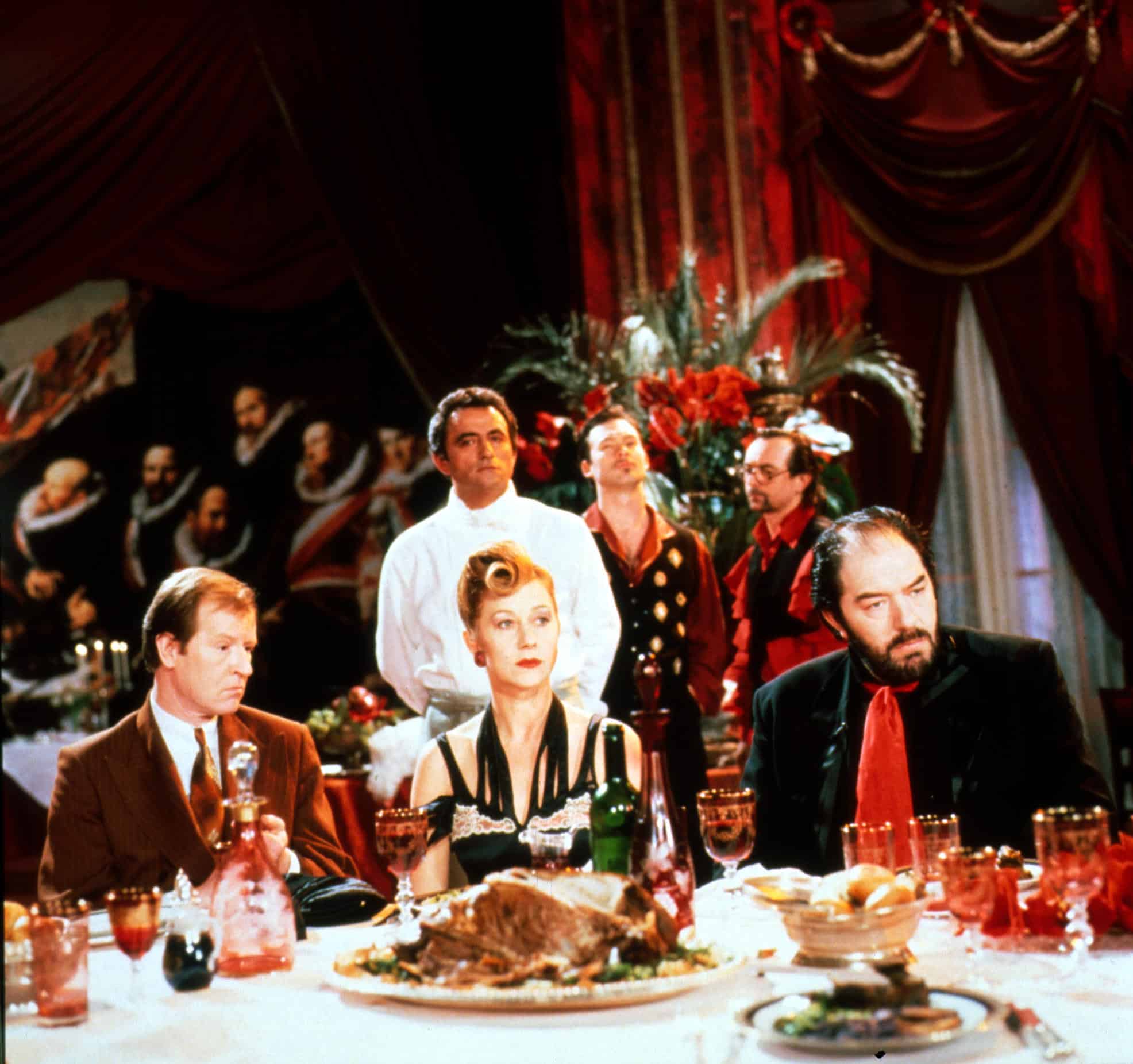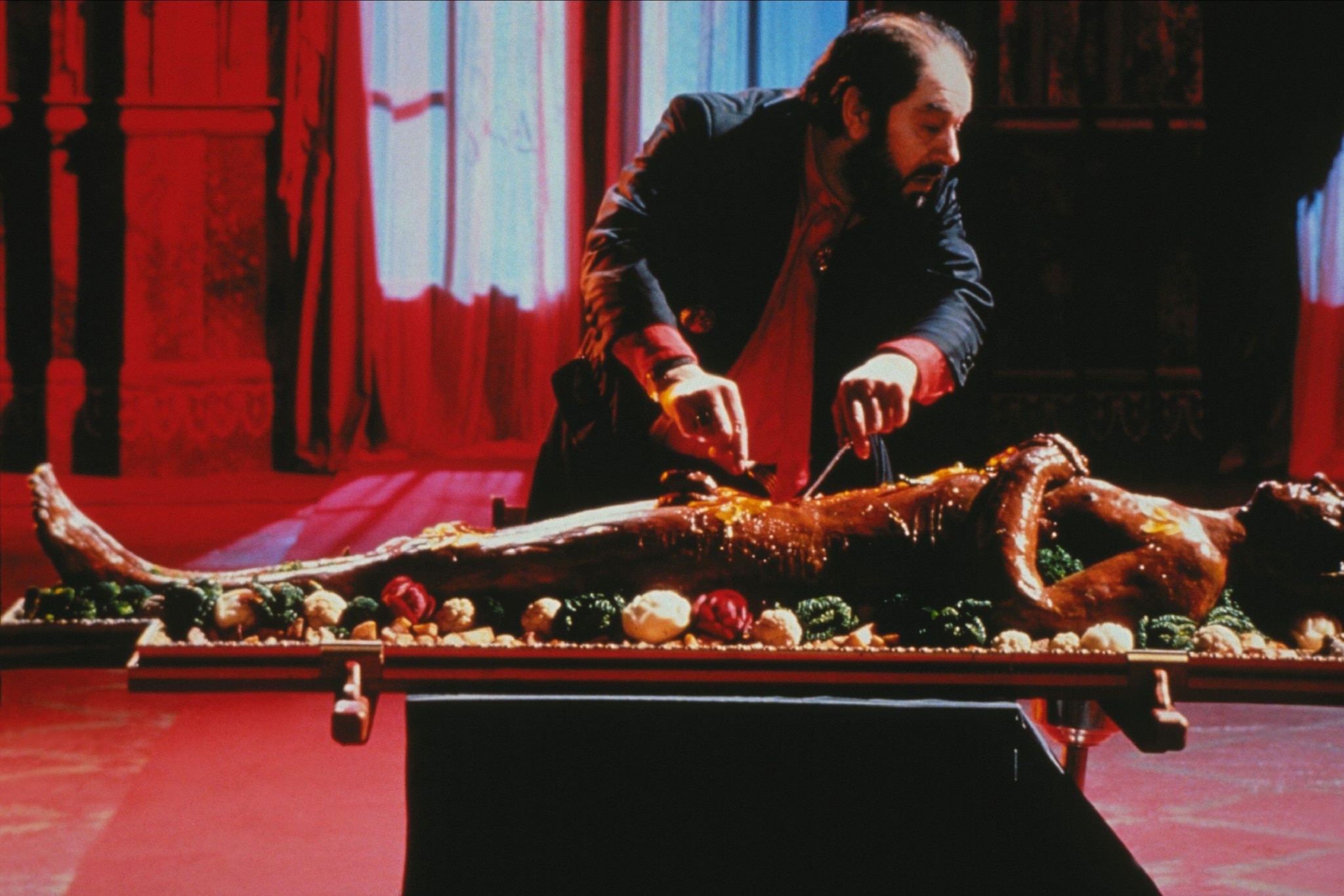
On it’s 35th anniversary, Finlay Renwick pens a sartorial appreciation of Peter Greenaway’s 1989 culinary classic.
Each night Albert Spica takes a seat at his table at Le Hollandais, a London restaurant that doubles as the vulgar gangster’s own fiefdom, a lavish den of depravity and excess, where he subjects anyone unfortunate enough to be within his vicinity to all sorts of elaborate and minor cruelties. He yelps like a feral creature, he hits and humiliates his wife, Georgina, and tortures kitchen boys, deriving a sadist’s sense of pleasure from the increasing, and very public, theatricality of his outbursts.
In an opening scene that will… stick with you, a man, who we are to understand is late in repaying a debt, is stripped naked and force-fed excrement by Albert and a pack of cronies, outfitted in pristine white shirts adorned with ruffles and lace. At the battleground of the table, Georgina is asked to repeat that she spends £400 per week on clothes and eats the finest cuisine. Albert is a nouveau riche interloper in this world, desperate for acceptance and desperate to tear at its walls.

Alan Howard, Helen Mirren, Michael Gambon and Richard Bohringer in The Cook, the Thief, His Wife & Her Lover (1989). By Peter Greenaway.
Thirty-five years after its initial release in 1989, Peter Greenaway’s The Cook, the Thief, His Wife & Her Lover still has the capacity to shock and compel. Given an X rating in America and, in its home country, considered a dark satire aimed at the state of Thatcher’s Britain, Greenaway’s cult classic possesses the intimacy of a play, with Sacha Vierny’s cinematography bathing it in the colour palette of a Caravaggio. The elaborate Victorian-meets-futurism costumes were conceived and designed by Jean Paul Gaultier, the self-taught enfant terrible of high fashion at that time.
The film is simple and brutal in its premise: Georgina, played by Helen Mirren, begins an affair with a solo diner, Michael, played by Alan Howard. Georgina and Michael’s nightly trysts takes place in the toilet, the kitchen, and the chef’s fridge, with Greenaway ingeniously shifting the colour palette—and respective outfits—to correspond with each change in environment: black and red for the dining room, white for the toilets, and green for the kitchen.

The film offers a constant, probing tension between that sense of glamour and decay. A dining room that is dark and oppressive, but also spectacular, draped in velvet and soft light.
Finlay Renwick
Originally trained as a fine artist, Greenaway told the author Brian McFarlane in 1990 that: “There is a mediaeval-like feeling in The Cook, the Thief about this rotten, worm-infested body which is covered in an extraordinary gloss of elaborate clothing, feathered hats and that sort of thing. It is as though there is an attempt to try and hide the horror, the despair, the sense of violence and lust that’s contained only just underneath.”
The film offers a constant, probing tension between that sense of glamour and decay. A dining room that is dark and oppressive, but also spectacular, draped in velvet and soft light. The kitchen is piled high with seafood and fruit, fowl, and game that look like they could spoil at any minute. More food than any one person could, or should eat. A fever dream.
While Albert gives off the impression of an ugly, overstuffed matador, or a dark cardinal, in wide lapels and shimmering black tailoring accented with scarlet sashes, Mirren’s Georgina is tethered somewhere between loyal wife and dominatrix, evolving as she does, from victim to lover to an exacter of revenge as she drifts, corseted and wrapped, between rooms and monochromatic colour schemes. Even the sex on screen has a sense of detachment, a kind of vivid nihilism that seeks destruction over pleasure.

Poster for The Cook, the Thief, His Wife & Her Lover (1989). By Peter Greenaway.
With his eye for subversion and a punkish sense of humour, inspired by an autodidact fashion education picked up from the clubs and streets of Paris, Gaultier was the perfect choice to shape the film’s wardrobe. “To show the relativity of what’s good taste and what’s not is something I like to play with,” he has said of his work, which includes a controversy-laden 1984 collection, intentionally designed to appear too tight on the catwalk models, called You Feel As Though You’ve Eaten Too Much. “I’m still astounded by some people’s reaction to things I consider quite normal,” was his response to the uproar.
Funny, repulsive, and stylish, The Cook, the Thief, His Wife & Her Lover is a corpse wrapped in silk rotting on the side of a road, a tactile masterpiece. Greenaway (with some help from Gaultier) concocted one of the great films about food, class, clothes, and sex. Despite the political undertones, the director has always been bullish about his aesthetic, telling Vulture, “I am not a realistic filmmaker. I believe cinema is imminently, and indeed eminently, artificial.”
“Let’s preserve that artificiality.”





